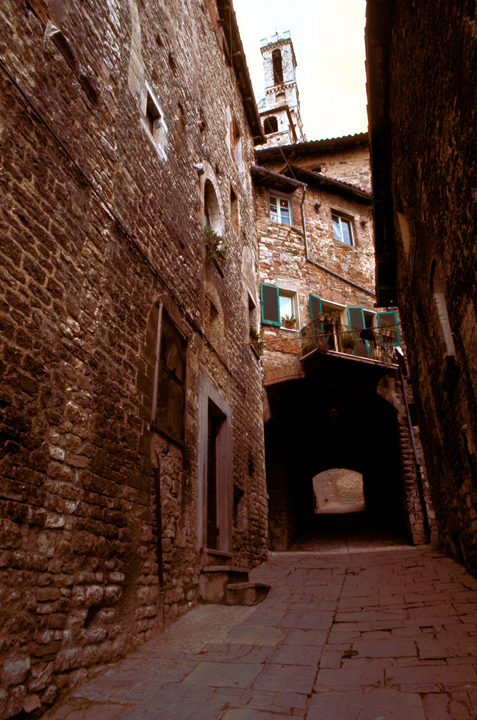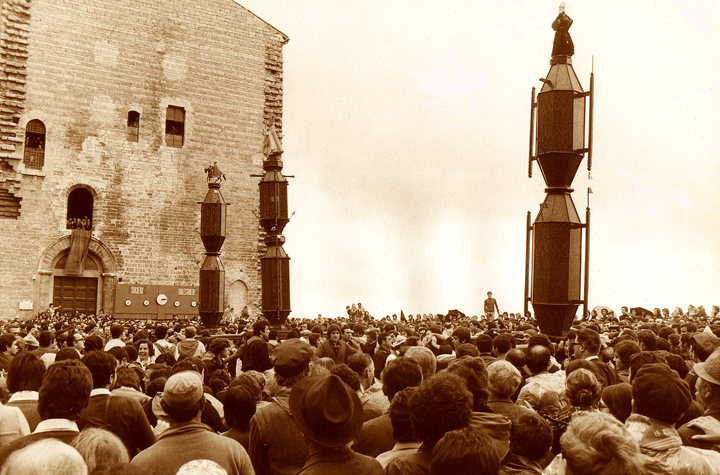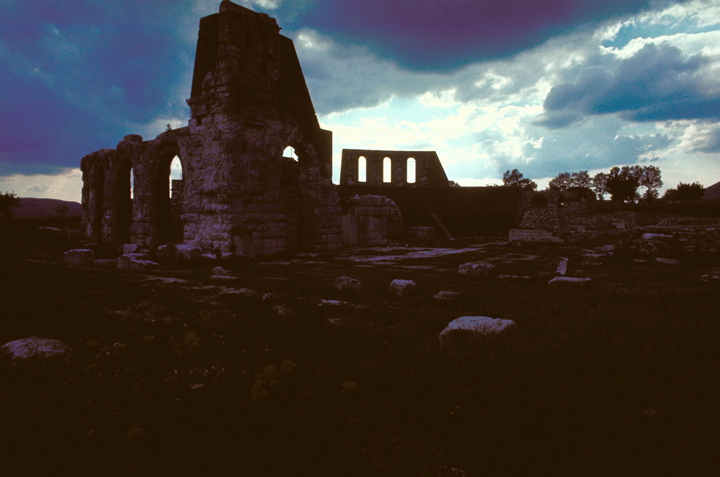
GREECE | BAMBINI | VINTAGE POSTER | SAN QUENTIN | SURREALISM | MODELS | HEADSHOTS | BELLYDANCE | EXOTICA | CONTACT US
All Rights Reserved. Please respect the copyright ownership and do not duplicate this article without permission.
Article and Photographs by Marino ColmanoJOY OF LIVING
Destiny brought me to experience one of the few remaining ancient religious celebration in Italy. Some say it is of Christian birth, other suspect that it survives from Pagan ceremonies.

While traveling through central Italy in search of medieval architecture, I arrived in Gubbio around sundown during a torrential rainstorm. This ancient and fabled town rests on the Western slope of Monte Ingino. Though it was long before the tourist season I was soon to discover no availability of rooms in any of the eight tiny inns. While taking cover from the rain, the reason for this surprising circumstance was explained to me by a local inhabitant that I met. He told me of the famed annual festival, "Corsa dei Ceri" that was to begin the following morning.
This festival, which takes place on the 15h of May, marks the eve of the feast of Saint Ubaldo, a day of solemn mass and meditation. In total contrast, the day of the "Ceri" traditionally is filled with medieval pageantry and religious fervor, highlighted with a procession.
My gentleman informant brought me to a taverna filled to capacity and throbbing with exuberant dancing and singing. Food and local wine par excellance was on the house. Even the wine cellar was cleared for the dancers, which included children. After hours of merriment, my newfound friends escorted me to a hillside ranch whose owners supplemented their income by operating as a private "tratoria." Pachito, the staunch young owner prided himself on his "Cowboy" lifestyle and questioned me enthusiastically about the American Indians.

Pachito graciously offered me the only remaining space in his house... a hayloft. With straw for a bed and the most fantastic open fire cooking of his young wife, I was delightfully accommodated for the remainder of my stay. It is here, at lunch on the terrace that I capured their youn son "Ubaldo," floating like an angelic figurine. His younger brother watching his mom cook "la foccacia" on the open fire.


Earlier when questioned, my hosts offered only vague information regarding the origin of the festival and of the "Ceri." Mentions were made of a pagan Goddess named "Ceres," of symbolic gestures toward their protector S. Ubaldo and it was suggested that the actual structure of the "Ceri" themselves, the focal point of the festival, was derived from the war chariot of a fabled Milanese leader. "Cero" translates in English as candle, but that was hardly a hint of what to expect. I retired with excited anticipation to my straw bed, the rain beating down on the barn roof.
At the crack of dawn a loud reveille beaten on drums aroused me. I hurried down the path into town to see what the commotion was all about. As I turned through the town gates I ran right into the first procession of the morning. I instinctively began shooting my cameras as brief intermittent spells of rainfall caused spectacular glints of moisture on the plastic rain caps of the marching musicians. A group of men were carrying three figurines representing S. Ubaldo protector of the masons, S. Giorgio patron of the merchants and S. Antonio favorer of agriculture. I joined the procession and we marched through every street in town walking the populous, enlisting them to join us. On one particular street we passed a convent with doors open where the nuns stood throwing blessed flowers to the joyous crowd. The swinging forward to catch a flower and therefore receive holy blessing was overwhelming.


By mid-day all were gathered in the great central square "Piazza Grande" bounded in the North by the 14th Century Palazzo dei Consuli and in the South by the Municipo (where one can find the original Eugubine Tables describing this curious custom depicted in an ancient Umbrian language employing a reverse "left to right" format).
An Ecclesiastical procession was forming headed by the "Attendants of the Dead" who walked in pairs and were clad in white robes with black capes. Next came members of the "Society of Santa Croce" in blue capes, next more men in black, followed by scholars of the seminary and several men in brown capes carrying the famed image of S. Ubaldo. Finally came the canons of the Cathedral with the Bishop and his attendants. The procession paused and the Bishop blessed the Palazzo and its people.

Suddenly the great doors of the Palazzo dei Consoli swung open and the three "Ceri" were rushed out into the center of the piazza carried horizontally. The mystery was finally solved! I could clearly see the "Ceri," three colossal wooden pedestals about twelve to fifteen feet long, in the form of eight sided prisms, pointed at both ends.
They suggested to me the shape of two lanterns fitted atop each other. The team of bearers consisted of ten men known as the "Ceraioli," clad in white trousers, blue shirts and brightly colored sashes wound several times around the waist.

The foreman of the "Ceraioli" is known as the "Capo Dieci" or leader of ten. At this pint the three Saintly figurines from the morning procession were fastened to the top of each "Cero." As water was spilled from jugs, which were then tossed into the air, the "Ceri" were raised vertically by the "Ceraioli" and with unusual speed and vigor carried southward along the Via dei Consoli.
As a trumpeter on horseback separated the crowd up front, the tiny two and one half foot figure of S. Ubaldo mounted atop the strange obelisk with garments fluttering was raced through the streets of his Gubbio.
At the Giardino Pubblico (public garden), another figure on horseback, the first Captain of the people, took command, leading the procession on several obstacle defying, breathtakingly paced circuits of the town streets. One stop only made for rest and wine during which the "Ceri" are brought to a horizontal repose.
Once more the pedestals were hoisted high for the final phase of the journey through the town gates and upward toward the ultimate destination, the Franciscan Monastery at the top of Monte Ingino. At first a dashing pace was resumed but slowly even the strongest "Ceraioli" were forced to walk as the slope became steeper. At this point the townspeople offered their help, holding guide ropes attached to the swaying pedestals.
Upon reaching the Monastery in late afternoon, the "Ceri" and their entire entourage tucked safely into the inner courtyard, the gates were closed. Finally, the "Ceri" were carried one by one in three circular runs around the courtyard and their journey was complete for yet another year.
The figurines were removed from their thrones on high and set to rest temporarily on individual benches inside the basilica whereupon the "Ceraioli" and the townsfolk came to humbly pay their final respects, bowing and placing affectionate kisses upon the "Ceri." The figurines were later to be taken downhill to their respective churches until the next festival, whereas the "Ceri" remain in seclusion at the Monastery.
As night fell the crowds slowly made their descent to town. The narrow pathway was aglow with flickering candles and the air was filled with harmonious blending of church bells. The picture was set, ending a remarkable day.

The following morning a fair began in Gubbio that was to last several days. People from near and far came to participate in selling their wares and an amusement park was set up for the children.
The rains had subsided and I mingled with the people, camera poised to capture the unique spirit ever present. To add yet another perfect ending, as the sun was setting, I discovered an ancient Roman Forum standing majestically in a large open field as if a token of that past era out of which came "La Corsa dei Ceri."

This celebration has earned Gubbio the reputation of being "A town of madmen." I disagree. It is more obviously a celebration of sincere love and enthusiasm toward their religion, God, and the anniversary of the death of their beloved S. Ubaldo.
 CLICK BACK TO CERI FOTOS
CLICK BACK TO CERI FOTOS
This article about the festival is available for editorial publication. Email with inquiries.  contact@marinocolmano.com
contact@marinocolmano.com
And click here for next page... LUCID MOMENTS GALLERY
PLEASE NOTE: ©2000 Marino Colmano. This website is a public relations presentation of Marino Colmano and Lucid Media, Inc. All photographs and editorial content that appear in this site are for the exclusive use of Marino Colmano and Lucid Media, Inc. for publicity purposes only. It is illegal and a violation of United States copyright laws to download photographs from this website. Any illegal use of the photographs is subject to prosecution to the extent provided by law. For information on how to obtain the rights and permissions to photographs included in this site, please contact Mr. Colmano.